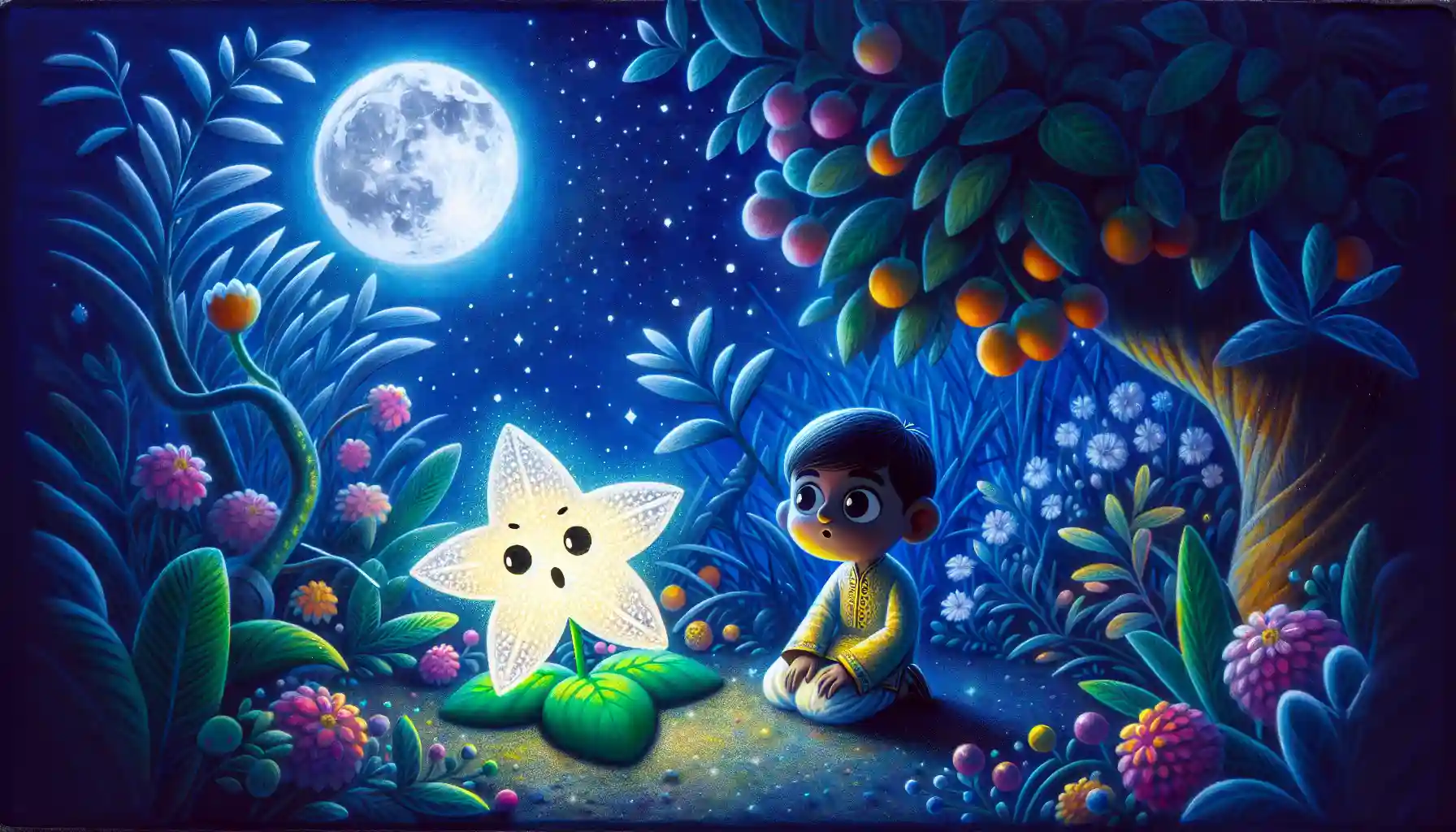A little star falls from the sky and loses its glow. A kind boy helps it find its spark and return to the sky.
Age Recommendation
3 - 8 years
Characters of The Star That Lost Its Spark
Characters:
- Leo (a kind and curious boy)
- Twinkle (a small star that lost its glow)
- The Moon (a wise and gentle guide in the sky)
Story of The Star That Lost Its Spark
Late one night, as Leo gazed out of his bedroom window, he saw something unusual—a tiny star falling from the sky. It landed softly in his garden, glowing faintly. Curious, Leo hurried outside. There, sitting on a flower, was a little star with teary eyes.
“Are you okay?” Leo asked gently. The star sniffled and said, “I’m Twinkle. I fell from the sky, and now I’ve lost my spark. I can’t shine anymore.” Leo’s heart ached for the little star. “Don’t worry, Twinkle. I’ll help you find your spark again.”
Together, they tried everything. Leo held up a flashlight, but Twinkle just giggled. “That’s not my kind of light!” They tried singing songs and even jumping on a trampoline to reach the sky, but nothing worked. Twinkle sighed. “Maybe I’ll never shine again.”
Then, a soft light bathed the garden. It was the Moon, glowing brightly in the sky. “Twinkle,” the Moon said kindly, “a star’s spark comes from spreading joy. You’ve already found it.” Twinkle looked confused. “But how?”
The Moon smiled. “Leo helped you because he cared. And you made him smile by being brave. That’s your spark—bringing light to others.” Twinkle beamed, her glow returning brighter than ever. “Thank you, Leo,” she said, spinning happily.
With a final hug, Leo watched Twinkle float back into the sky, her light twinkling among the stars. As he went to bed, he whispered, “Goodnight, Twinkle.” And in the sky, Twinkle winked back.
The end.
Moral of the Story
Helping others and sharing joy can bring light to everyone, including yourself. Kindness makes the world—and even the stars—shine brighter.
Questions to Think About
- Why did Twinkle lose her spark?
- How did Leo help Twinkle find her glow again?
- What does it mean to spread joy to others?
Do You Know
- Stars are giant balls of gas that shine because they burn very hot!
- The Moon doesn’t make its own light—it reflects the Sun’s light.
Word Explorer
- Twinkle: A small, bright, flickering light.
- Glow: A soft, steady light.
- Spark: A small burst of light or energy.
Emotions in the Story
- Sadness: When Twinkle loses her spark.
- Kindness: Leo helping Twinkle without hesitation.
- Happiness: When Twinkle shines brightly again.
Color Your Scene
Draw the moment when Leo finds Twinkle sitting on a flower, glowing faintly under the moonlight. What colors would you use for Twinkle’s light and the glowing moon? Add stars twinkling in the sky as Twinkle returns home!
Parents' Corner
Talk to your child about how acts of kindness can brighten someone’s day, just like Leo helped Twinkle. Discuss how spreading joy, even in small ways, can make the world a better place.
- 10 Minute Bedtime Stories
- 15 Minute Bedtime Stories
- 2 minute bedtime stories
- 20 Minute Bedtime Stories
- 3 Minute Bedtime Stories
- 5 Minute Bedtime Stories
- Adventure stories
- Animal stories
- Baby stories
- Bedtime Stories About Friendship
- Bedtime Stories For 10 Year Olds
- Bedtime Stories For 2 Year Olds
- Bedtime Stories For 3 Year Olds
- Bedtime Stories For 4 Year Olds
- Bedtime Stories For 5 Year Olds
- Bedtime Stories For 6 Year Olds
- Bedtime Stories For 7 Year Olds
- Bedtime Stories For 8 Year Olds
- Bedtime Stories For 9 Year Olds
- Bedtime stories for boys
- Bedtime stories for girlfriend
- Bedtime stories for girls
- Bedtime Stories For Preschoolers
- Bedtime Stories For Toddlers
- Bedtime stories with cats
- Bedtime Stories with dogs
- Bedtime stories with pets
- Best bedtime stories
- Campfire stories for kids
- Childhood stories
- Children's funny & humorous short stories
- Children's stories about feelings
- Children's Stories About Grandparents
- Children's Stories With Bears
- Children's Stories With Birds
- Children's Stories With Bunnies
- Children's Stories With Grandmas
- Children's Stories With Lions
- Dialogue Stories
- Dinosaur Bedtime Stories
- Entertaining Short Stories
- Fairy Tales
- Famous Fairy Tales
- Famous Short Stories
- Ghost stories for children
- Good bedtime stories
- Long Bedtime Stories
- Long Bedtime Stories for Girlfriend
- Love Bedtime Stories
- Magic stories
- Moral stories
- Motivational Stories For Kids
- Pirate stories
- Popular bedtime stories
- Princess Bedtime Stories
- Quick Bedtime Stories
- Romantic bedtime stories
- Scary Ghost Stories
- Scary stories for kids
- Short Bedtime Stories
- Short Bedtime Stories for Adults
- Short Bedtime Stories for Kindergarteners
- Short Stories For 1st Graders
- Short Stories For 2nd Graders
- Short Stories For 3rd Graders
- Short Stories For 4th Graders
- Short stories for 5th graders
- Short Stories For 6th Graders
- Short Stories For 7th Graders
- Short Stories For Elementary Students
- Short stories for kids
- Short stories for Middle School Students
- Short stories with heroes
- Short stories with moral lessons
- Spooky stories
- Stories about being in danger
- Stories About Courage And Bravery For Kids
- Stories about forgiveness
- Stories about kindness
- Stories That Rhyme
- Stories With Castles And Kingdoms
- Stories with dragons
- Stories With Monsters, Beasts And Wild Creatures
- Uncategorized
- Unicorn stories
- Very Short Stories For Kids
- Witch Stories











